The UFO Galaxy is a spiral galaxy located approximately 30.53 million light-years away in the northern constellation Lynx. It has an apparent magnitude of 10.6 and an apparent size of 9.3 by 2.2 arcminutes. It is catalogued as NGC 2683 in the New General Catalogue.
NGC 2683 was nicknamed the UFO Galaxy by the Astronaut Memorial Planetarium and Observatory (AMPO) site because the galaxy’s flattened shape with a large central bugle resembles a flying saucer from old science fiction films.
The UFO Galaxy is smaller and less luminous than our own galaxy, the Milky Way. It shows a low rate of star formation, with little molecular hydrogen or neutral hydrogen, which are usually present in stellar nurseries.
Despite its smaller size, NGC 2683 has twice as many globular clusters as the Milky Way. Astronomers have detected around 300. These clusters are much younger than those discovered in our galaxy. They have an estimated age of around 3 billion years, while Milky Way globulars are typically over 10 billion years old.
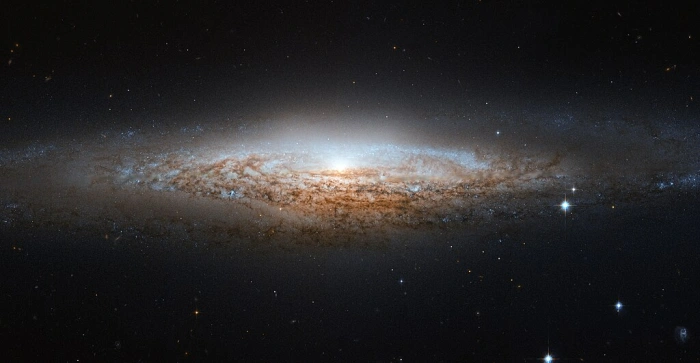
The NASA Hubble Space Telescope has spotted the “UFO Galaxy.” NGC 2683 is a spiral galaxy seen almost edge-on, giving it the shape of a classic science fiction spaceship. This is why the astronomers at the Astronaut Memorial Planetarium and Observatory, Cocoa, Fla., gave it this attention-grabbing nickname. While a bird’s eye view lets us see the detailed structure of a galaxy (such as this Hubble image of a barred spiral), a side-on view has its own perks. In particular, it gives astronomers a great opportunity to see the delicate dusty lanes of the spiral arms silhouetted against the golden haze of the galaxy’s core. In addition, brilliant clusters of young blue stars shine scattered throughout the disc, mapping the galaxy’s star-forming regions. Perhaps surprisingly, side-on views of galaxies like this one do not prevent astronomers from deducing their structures. Studies of the properties of the light coming from NGC 2683 suggest that this is a barred spiral galaxy, even though the angle we see it at does not let us see this directly. This image is produced from two adjacent fields observed in visible and infrared light by Hubble’s Advanced Camera for Surveys. Image credit: ESA/Hubble & NASA (CC BY 4.0)
The UFO Galaxy is a field galaxy. It is not a member of a larger galaxy cluster or group. It was once thought to lie closer to Earth, with estimates in the range between 16 and 25 million light-years, but more recent studies place it much farther away.
NGC 2683 is around 122,000 light-years across. It appears almost edge-on when seen from Earth. While most sources classify it as an unbarred spiral galaxy, recent studies suggest that it may really be a barred spiral. However, the galaxy’s inclination makes it difficult to confirm the presence of a central bar.
In 2009, a team of astronomers led by Rachel Kuzio de Naray of the Center for Cosmology, Department of Physics and Astronomy, University of California, reported the detection of a figure-of-eight velocity structure in the inner 45 arcseconds of the galaxy. The team also found that the galaxy isophotes – curves that connect points with the same intensity of light – were boxy. These findings may be evidence of a bar structure.
In 2016, astronomers found that NGC 2683 had regions of relatively low brightness bordered by “spurs” along the galaxy’s long axis, indicating that these regions were boxy. The X-shaped structure near the galaxy’s centre may be linked with a stellar bar.
NGC 2683 is receding from us at 411 km/s. It is moving away from the Galactic centre at 375 km/s.
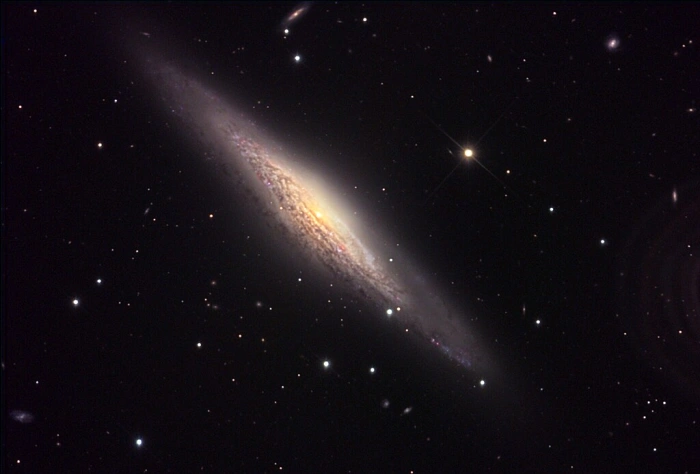
The spiral galaxy NGC 2683 is viewed nearly edge-on from our perspective. The reddened light from the center of the galaxy appears yellowish due to thousands of light years of intervening gas and dust in the outer arms of this galaxy. The core just just be glimpsed through the last wall of dust in the center. This image was taken as part of Advanced Observing Program (AOP) program at Kitt Peak Visitor Center during 2014. Credit: KPNO/NOIRLab/NSF/AURA/Doug Matthews/Adam Block (CC BY 4.0)
The galaxy has several dwarf companions. The smaller galaxies are catalogued as KK 69 (LEDA 166095), KK70 (LEDA 166096), N2683dw1 and N2683dw2. These galaxies appear at a separation of 23 arcminutes (62 kpc), 30 arcminutes (82 kpc), 7 arcminutes (19 kpc), and 10 arcminutes (27 kpc) from NGC 2683.
KK 69 is the largest of these satellite galaxies. It has a Holmberg diameter of 12,000 light-years. It is classified as a dwarf transitional galaxy, between a dwarf irregular and dwarf spheroidal galaxy. KK 70 is half the size of KK 69. The smaller N2683dw1 is a dwarf irregular galaxy and N2683dw2 is a dwarf spheroidal galaxy.
The UFO Galaxy is the most massive member of the group. It is showing signs of external gas accretion, indicating that it is interacting with the smaller galaxies.
The light from the galactic centre of NGC 2683 appears reddened and yellowish because of the dust and gas in the galaxy’s outer spiral arms.
There may be another smaller companion near the northeastern side of the UFO Galaxy’s HI disk. Its presence was reported by an international team of astronomers in 2020. The study was based on observations with the Giant Metrewave Radio Telescope (GMRT) in India, operated by the National Centre for Radio Astrophysics (NCRA).
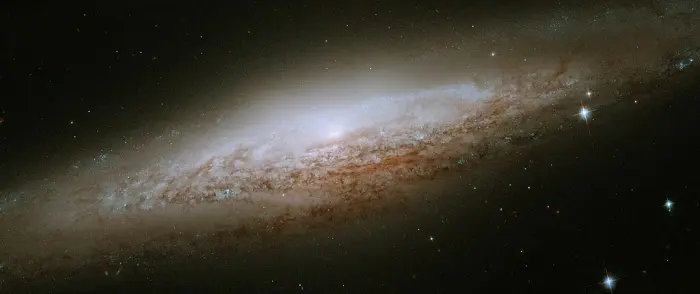
A large mosaic Hubble Space Telescope image of the UFO Galaxy (NGC 2683), credit: Hubble Legacy Archive, ESA, NASA; Processing: Nikolaus Sulzenauer (CC BY 3.0)
Facts
The galaxy NGC 2683 was discovered by the German-born British astronomer Sir William Herschel on February 5, 1788. Herschel saw the galaxy with his 18.7-inch reflector and catalogued it as I 200, noting, “Very brilliant, much elongated, south preceding north following, 8’ long 3’ broad beautiful.”
The UFO Galaxy can be seen in small and medium telescopes in good conditions. It is not listed in the Messier and Caldwell catalogues, but it is included in the Herschel 400 catalogue of deep sky objects visible in amateur telescopes. It is one of three objects in the constellation Lynx on the Herschel 400 observing list, along with the globular cluster NGC 2419, popularly known as the Intergalactic Wanderer, and the peculiar spiral galaxy NGC 2782.
The UFO Galaxy is one of the best-known edge-on galaxies in the sky, along with the Sombrero Galaxy (Messier 104) in the constellation Virgo, the Silver Sliver Galaxy (NGC 891) in Andromeda, and the Needle Galaxy (NGC 4565) in Coma Berenices.
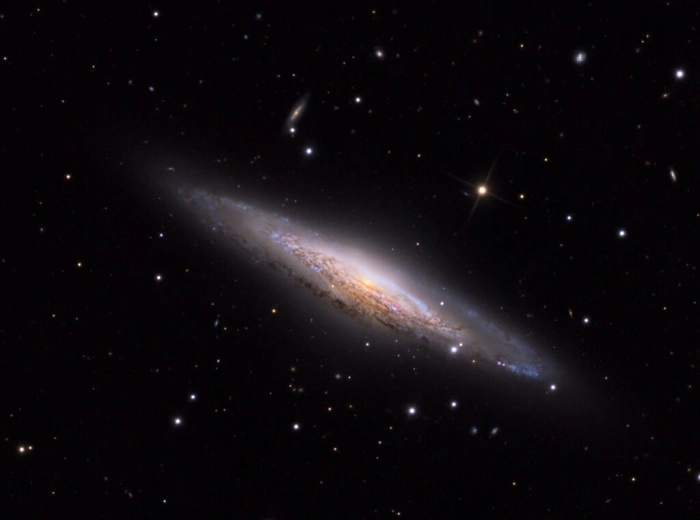
UFO Galaxy, image credit: Adam Block/Mount Lemmon SkyCenter/University of Arizona (CC BY-SA 3.0 US)
Location
The UFO Galaxy lies in the faint constellation of Lynx. It can be found by drawing a line from the orange giant Alpha Lyncis to the midpoint of the imaginary line connecting Pollux and Castor in Gemini.
Alpha Lyncis shines at magnitude 3.14 and does not stand out in the sky. It can be found using the three pairs of stars that form the Three Leaps of the Gazelle, a relatively bright asterism in the constellation Ursa Major (the Great Bear). Alpha Lyncis lies roughly halfway between Talitha and Alkaphrah, the stars that form the Third Leap and mark the front paws of the Great Bear, and Epsilon Leonis in the constellation Leo. Epsilon Leonis is part of the Sickle, a star pattern that represents the Lion’s head and mane.
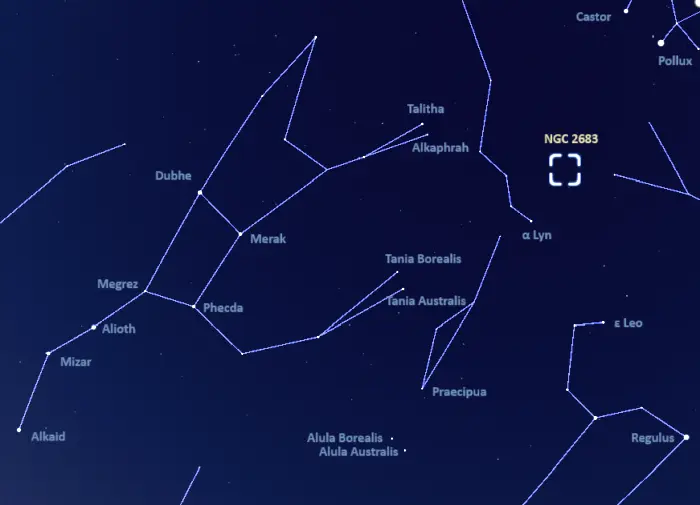
The location of the UFO Galaxy (NGC 2683), image: Stellarium
At declination +33° 25’, NGC 2683 is visible from locations north of the latitude 55-56° S and best seen from the northern hemisphere. The best time of the year to observe the galaxy and other deep sky objects in Lynx is during the month of February, when the constellation climbs higher above the horizon in the early evening.
UFO Galaxy – NGC 2683
| Constellation | Lynx |
| Object type | Spiral galaxy |
| Morphological type | SA(rs)b |
| Right ascension | 08h 52m 41.3064829584s |
| Declination | +33° 25′ 18.597681516″ |
| Apparent magnitude | 10.6 |
| Apparent size | 9.3’ x 2.2’ |
| Distance | 30.53 ± 0.91 million light-years (9.36 ± 0.28 megaparsecs) |
| Redshift | 411 ± 1 km/s |
| Size | 122,000 light years (37,500 parsecs) |
| Names and designations | UFO Galaxy, NGC 2683, PGC 24930, LEDA 24930, UGC 4641, MCG+06-20-011, SDSS J085241.32+332518.4, KUG 0849+336, UZC J085241.8+332521, 87GB 084932.5+333654, IRAS 08495+3336, IRAS F08495+3336, PSCz Q08495+3336, QDOT B0849352+333648, [VDD93] 83, [M98c] 084934.8+333623, 2MASX J08524134+3325184, Z 0849.6+3336, Z 180-17, Gaia DR3 713195266714763648 |